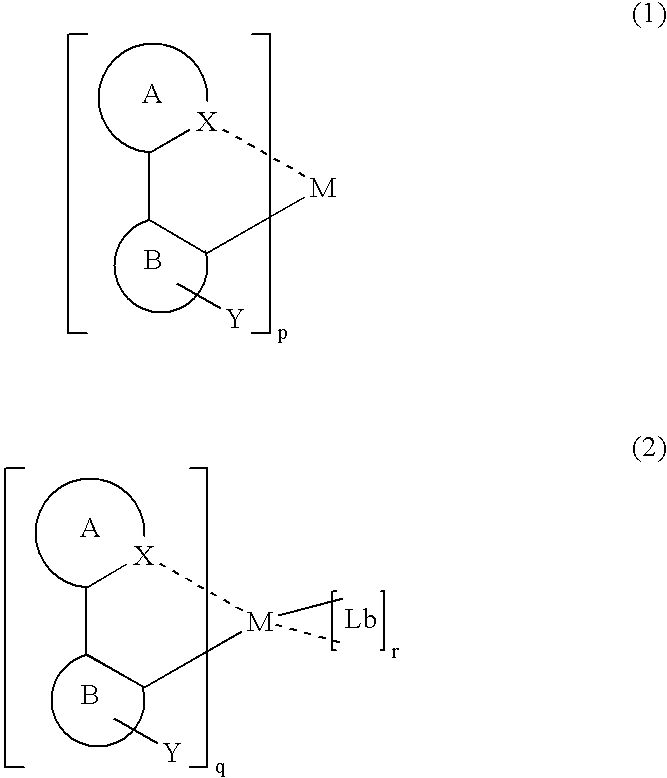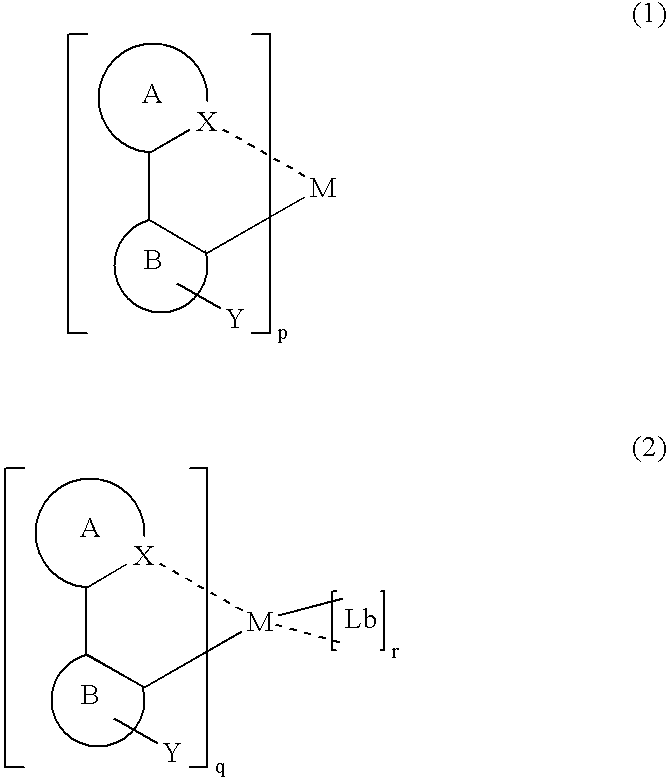Luminescent organometallic compound and light emitting device
a technology of organometallic compound and light emitting device, which is applied in the direction of discharge tube luminescnet screen, other domestic articles, natural mineral layered products, etc., can solve the problems of increasing the reliability of peripheral driving circuit, increasing the cost, and affecting the operation of peripheral electronic devices, and achieve excellent luminous efficiency
- Summary
- Abstract
- Description
- Claims
- Application Information
AI Technical Summary
Benefits of technology
Problems solved by technology
Method used
Image
Examples
example 1
Synthesis of tris(2-(3,5-difluorophenyl-1-yl)-pyridinato-N,C2′) iridium(III)
[0068]As a reaction vessel, a four neck flask of about 500 cm3 in volume, made of borosilicate glass was prepared (hereinafter, simply referred to as a reaction vessel), and a babbled shaped Allihn type water-cooling condenser tube of which cooling part is about 20 cm long (hereinafter, simply referred to as a condenser) was connected to the reaction vessel so as to ensure airtightness at the common taper joint. A mechanic-type stirrer made up of a motor, a joint, a glass stirring bar and a stirring blades of fluorine resin, and an airtight seal through which the stirring bar is penetrated were connected to a connection port on the top of the reaction vessel, so that efficient stirring of the contents in the reaction vessel was ensured while keeping the airtightness. An enclosure-type connection tube for introducing inert gas was connected to one of connection ports on the side of the reaction vessel, making...
example 2
Synthesis of bis(2-(7-fluorobenzothiophene-2′-yl)-pyridinato-N,C2′)acetylacetonato iridium (III)
[0074]The reaction was conducted in the same manner as in Example 1 except that diethylene glycol as the reaction solvent, 1 mmol of iridium chloride (III) as the first material and 2.5 mmol of 2-(6-fluorobenzothiophene-2′-yl)pyridine as the second material were used, and an intermediate which is considered as a dinuclear complex of iridium was synthesized.
[0075]Next, the reaction was conducted in the same manner as in Example 1 except that a four neck flask of about 100 cm3 in volume as the reaction vessel, diethylene glycol as the reaction solvent, 0.1 mmol of the above-mentioned intermediate as the first material, 0.25 mmol of acetyl acetone as the ligand, 110 mg of sodium carbonate as an absorber for leaving chlorine were used, and an objective organometallic compound was obtained. This compound was irradiated with an ultraviolet ray having a wavelength of about 370 nm, and then red l...
example 3
Synthesis of tris(2-(4-fluorophenyl-1-yl)-pyridinato-N,C2′) rhenium (III)
[0076]The reaction was conducted in the same manner as in Example 1 except that 1,3-dinitrobenzene as the reaction solvent, 1 mmol of rhenium chloride (III) as the first material, (4-fluorophenyl-1-yl)-pyridine as the second material were used, and an objective organometallic compound was obtained. This compound was irradiated with an ultraviolet ray having a wavelength of about 370 nm, and then blue light emission was observed. Atomic analysis of the substance after sublimation purification resulted in a composition that almost coincides with the expected composition.
PUM
| Property | Measurement | Unit |
|---|---|---|
| Luminescence | aaaaa | aaaaa |
| Chemical structure | aaaaa | aaaaa |
Abstract
Description
Claims
Application Information
 Login to View More
Login to View More - R&D
- Intellectual Property
- Life Sciences
- Materials
- Tech Scout
- Unparalleled Data Quality
- Higher Quality Content
- 60% Fewer Hallucinations
Browse by: Latest US Patents, China's latest patents, Technical Efficacy Thesaurus, Application Domain, Technology Topic, Popular Technical Reports.
© 2025 PatSnap. All rights reserved.Legal|Privacy policy|Modern Slavery Act Transparency Statement|Sitemap|About US| Contact US: help@patsnap.com



